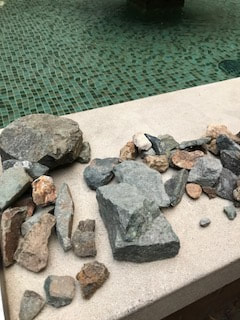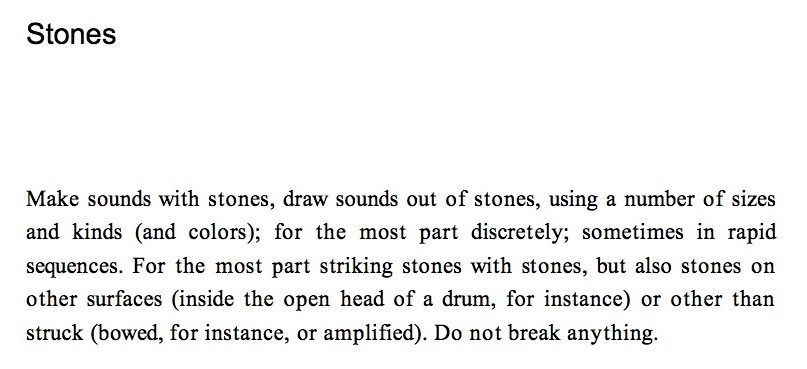Hunter led us on a great walk around campus this week. The sounds gradually grew in volume to a climax of generators/AC units humming, and our return to the music building acted as a decrescendo. In our discussion following the walk, one person commented on how the flow could be interpreted as musical in its form.
Following the walk, Luna (a music therapy student) led us through an improvisation to conclude our time. We each chose rocks of various sizes and took them to a fountain in the education building.
Following the walk, Luna (a music therapy student) led us through an improvisation to conclude our time. We each chose rocks of various sizes and took them to a fountain in the education building.
To begin, we each organized our “set” of stones from smallest to largest. We then took turns dropping stones into the fountain one-by-one, starting with the largest rocks first. This helped get us accustomed to the sounds (and pitches!) of our “instruments.” After all the rocks were in the fountain, we fished them out and talked about the sounds. Luna led us through a few more exercises, framing each one in a slightly different way – taking turns each dropping a rock, each of us dropping one rock all together, all of us dropping a stone from different corners of the fountain, etc. We even unintentionally built a major triad at one point!
We ended our session with a few free improvisations. Rhythm and timing became a more prominent player at this point, resulting in some very cool moments. The consistent running water of the fountain became more noticeable to me as well.
A huge part of this experience was handling the rocks, feeling the weight, size, and texture of each one. For me, this tangible aspect helped increase my awareness of the sounds the stones made as they hit the water. I’m sure setting the rock into motion in order to make a sound also contributed.
We reflected that this exercise bounced back and forth, at times feeling like creating music and at other times being more playful in nature. And both were great! I highly recommend dropping stones into water either by yourself or with a friend. It was relaxing yet engaging all at once. Plus, the “found object” nature of the stones as instruments may promote openness to other nontraditional music possibilities.
(And don’t worry, we removed all rocks from the fountain and returned them to their original location.)
Wednesday, April 25, 2018
5:45 - 6:15pm
Sunny
We ended our session with a few free improvisations. Rhythm and timing became a more prominent player at this point, resulting in some very cool moments. The consistent running water of the fountain became more noticeable to me as well.
A huge part of this experience was handling the rocks, feeling the weight, size, and texture of each one. For me, this tangible aspect helped increase my awareness of the sounds the stones made as they hit the water. I’m sure setting the rock into motion in order to make a sound also contributed.
We reflected that this exercise bounced back and forth, at times feeling like creating music and at other times being more playful in nature. And both were great! I highly recommend dropping stones into water either by yourself or with a friend. It was relaxing yet engaging all at once. Plus, the “found object” nature of the stones as instruments may promote openness to other nontraditional music possibilities.
(And don’t worry, we removed all rocks from the fountain and returned them to their original location.)
Wednesday, April 25, 2018
5:45 - 6:15pm
Sunny

